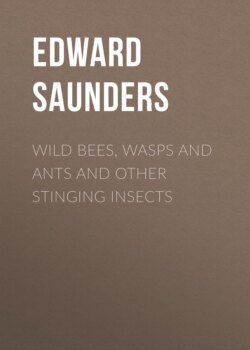Читать книгу Wild Bees, Wasps and Ants and Other Stinging Insects - Edward Saunders - Страница 10
На сайте Литреса книга снята с продажи.
THE CUCKOO BEES
ОглавлениеTable of Contents
These cuckoos live at the expense of their hosts. The mother of the industrial brood makes her cell and provisions it, and lays her egg. The cuckoo bee manages to enter also and lay her egg in the same cell, the usual result being that the cuckoo devours most of the food instead of the rightful offspring, which gradually gets starved and dies, the cuckoo appearing in its place; but there have been cases, how frequent they are is difficult to say, in which both offsprings have emerged.
The whole problem of the relationships between host and cuckoo is most interesting. In some cases the cuckoos are so like their hosts that it is difficult to tell one from the other, in others they are so unlike that it is difficult to trace any resemblance between them. There are a great number of different kinds of cuckoos, and most of them select a special host to associate with, and are never found except with that species. There are, however, cases of cuckoos which visit the nests of more than one host, and cases of hosts which are visited by several kinds of cuckoos. In the short-tongued bees, with the exception of Halictus and Sphecodes, the cuckoos are quite unlike their hosts both in form and colour. In the Andrenas (the lawn bee being one of them) the hosts are clothed with reddish, or brown and black, hairs, and are of a more or less stout build (pl. B, 15, 16). The cuckoos are elegant in shape, almost devoid of hairs, and most of them are striped with yellow or brown across the body so that they present a wasp-like appearance (pl. B, 18). Species more unlike one another than host and cuckoo one could hardly imagine; still this stranger seems to get access to the nest of its host without opposition. In a colony of Andrena one may see the cuckoos (which rejoice in the name of Nomada or wanderers) flying about among the females of the industrious bee, and no alarm or concern appears to be felt by the latter. As we go up in the scale of bees, i.e. towards the more specialized, and arrive at those with longer tongues, the cuckoos are found as a rule to resemble their hosts more closely, both in colour and structure, and when we reach the social genus Bombus (i.e. the humble bees) we find the cuckoos so like their hosts (pl. D, 30, 31) that even entomologists of experience mistake one for the other. Apis (the hive bee) has no cuckoo. It seems to be theoretically probable that both cuckoo and host once originated from common parents; this is suggested by the similarity of structure of certain parts of both host and cuckoo, even in cases where they are otherwise most dissimilar. Andrena and Nomada, for instance, which are very unlike, as stated above, agree in both having very feeble stings and in possessing three conspicuous spines on the upper and posterior edge of the orbit of the larva. Also, although Andrena the host has a short tongue, and Nomada, its cuckoo, a long one, the appendages (labial palpi) of the latter's tongue are framed on the same plan as those of the tongue of Andrena, and are quite unlike those of the other long-tongued bees. On the other hand, the cuckoos of the social species resemble them so closely in structure as well as appearance that it is more necessary to search for points of difference than of similarity. There is only one case known of a cuckoo wasp, and that resembles its host even more closely than do the cuckoos of the humble bees. All these points certainly suggest the probability that the social bees and wasps and their cuckoos adopted different habits at a much more recent date than the solitary species, and therefore have not had so much time to become differentiated in structure. The only short-tongued bees which have cuckoos of similar structure are the species of Halictus (pl. B, 12); their cuckoos, Sphecodes (pl. B, 11), are closely allied to them, but then Halictus and Sphecodes are most peculiar genera; although short-tongued, their females spend the winter in the earth, as do the social bees and wasps (see p. 13), and they colonize largely, which may prove to be a step towards socialism.
